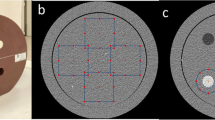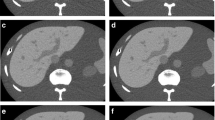Abstract
Objectives
To assess the impact of a new artificial intelligence deep-learning reconstruction (Precise Image; AI-DLR) algorithm on image quality against a hybrid iterative reconstruction (IR) algorithm in abdominal CT for different clinical indications.
Methods
Acquisitions on phantoms were performed at 5 dose levels (CTDIvol: 13/11/9/6/1.8 mGy). Raw data were reconstructed using level 4 of iDose4 (i4) and 3 levels of AI-DLR (Smoother/Smooth/Standard). Noise power spectrum (NPS), task-based transfer function (TTF) and detectability index (d′) were computed: d′ modelled detection of a liver metastasis (LM) and hepatocellular carcinoma at portal (HCCp) and arterial (HCCa) phases. Image quality was subjectively assessed on an anthropomorphic phantom by 2 radiologists.
Results
From Standard to Smoother levels, noise magnitude and average NPS spatial frequency decreased and the detectability (d′) of all simulated lesions increased. For both inserts, TTF values were similar for all three AI-DLR levels from 13 to 6 mGy but decreased from Standard to Smoother levels at 1.8 mGy. Compared to the i4 used in clinical practice, d′ values were higher using the Smoother and Smooth levels and close for the Standard level. For all dose levels, except at 1.8 mGy, radiologists considered images satisfactory for clinical use for the 3 levels of AI-DLR, but rated images too smooth using the Smoother level.
Conclusion
Use of the Smooth and Smoother levels of AI-DLR reduces the image noise and improves the detectability of lesions and spatial resolution for standard and low-dose levels. Using the Smooth level is apparently the best compromise between the lowest dose level and adequate image quality.
Key Points
• Evaluation of the impact of a new artificial intelligence deep-learning reconstruction (AI-DLR) on image quality and dose compared to a hybrid iterative reconstruction (IR) algorithm.
• The Smooth and Smoother levels of AI-DLR reduced the image noise and improved the detectability of lesions and spatial resolution for standard and low-dose levels.
• The Smooth level seems the best compromise between the lowest dose level and adequate image quality.






Similar content being viewed by others
Abbreviations
- AI-DLR:
-
Artificial intelligence deep-learning reconstruction
- CNN:
-
Convolutional neural network
- CT:
-
Computed tomography
- FBP:
-
Filtered back projection
- HCCa:
-
Hepatocellular carcinoma at the arterial phase
- HCCp:
-
Hepatocellular carcinoma at the portal phase
- IR:
-
Iterative reconstruction
- LM:
-
Liver metastasis
- NPS:
-
Noise power spectrum
- ROI:
-
Region of interest
- TTF:
-
Task-based transfer function
References
Willemink MJ, Noel PB (2019) The evolution of image reconstruction for CT-from filtered back projection to artificial intelligence. Eur Radiol 29:2185–2195
Boedeker K (2019) AiCE deep learning reconstruction: bringing the power of ultra-high resolution CT to routine imaging. Technical white paper on deep learning reconstruction Canon Medical system. https://global.medical.canon/publication/ct/2019WP_AiCE_Deep_Learning
Hsieh J, Liu E, Nett B, Tang J, Thibault JB, Sahney S (2019) A new era of image reconstruction: TrueFidelityTM. Technical white paper on deep learning image reconstruction. https://www.gehealthcare.com/-/jssmedia/040dd213fa89463287155151fdb01922.pdf
Akagi M, Nakamura Y, Higaki T et al (2019) Deep learning reconstruction improves image quality of abdominal ultra-high-resolution CT. Eur Radiol 29:6163–6171
Akagi M, Nakamura Y, Higaki T, Narita K, Honda Y, Awai K (2020) Deep learning reconstruction of equilibrium phase CT images in obese patients. Eur J Radiol 133:109349
Benz DC, Benetos G, Rampidis G et al (2020) Validation of deep-learning image reconstruction for coronary computed tomography angiography: impact on noise, image quality and diagnostic accuracy. J Cardiovasc Comput Tomogr 14:444–451
Bernard A, Comby PO, Lemogne B et al (2021) Deep learning reconstruction versus iterative reconstruction for cardiac CT angiography in a stroke imaging protocol: reduced radiation dose and improved image quality. Quant Imaging Med Surg 11:392–401
Brady SL, Trout AT, Somasundaram E, Anton CG, Li Y, Dillman JR (2021) Improving image quality and reducing radiation dose for pediatric CT by using deep learning reconstruction. Radiology 298:180–188
Franck C, Zhang G, Deak P, Zanca F (2021) Preserving image texture while reducing radiation dose with a deep learning image reconstruction algorithm in chest CT: a phantom study. Phys Med 81:86–93
Greffier J, Hamard A, Pereira F et al (2020) Image quality and dose reduction opportunity of deep learning image reconstruction algorithm for CT: a phantom study. Eur Radiol 30:3951–3959
Greffier J, Frandon J, Si-Mohamed S et al (2021) Comparison of two deep learning image reconstruction algorithms in chest CT images: a task-based image quality assessment on phantom data. Diagn Interv Imaging. https://doi.org/10.1016/j.diii.2021.08.001
Greffier J, Dabli D, Frandon J et al (2021) Comparison of two versions of a deep learning image reconstruction algorithm on CT image quality and dose reduction: a phantom study. Med Phys 48:5743–5755
Hata A, Yanagawa M, Yoshida Y et al (2021) The image quality of deep-learning image reconstruction of chest CT images on a mediastinal window setting. Clin Radiol 76:155 e115–155 e123
Higaki T, Nakamura Y, Zhou J et al (2020) Deep learning reconstruction at CT: phantom study of the image characteristics. Acad Radiol 27:82–87
Ichikawa Y, Kanii Y, Yamazaki A et al (2021) Deep learning image reconstruction for improvement of image quality of abdominal computed tomography: comparison with hybrid iterative reconstruction. Jpn J Radiol. https://doi.org/10.1007/s11604-021-01089-6
Jensen CT, Liu X, Tamm EP et al (2020) Image quality assessment of abdominal CT by use of new deep learning image reconstruction: initial experience. AJR Am J Roentgenol 215:50–57
Kawashima H, Ichikawa K, Takata T et al (2020) Performance of clinically available deep learning image reconstruction in computed tomography: a phantom study. J Med Imaging (Bellingham) 7:063503
Kim I, Kang H, Yoon HJ, Chung BM, Shin NY (2020) Deep learning-based image reconstruction for brain CT: improved image quality compared with adaptive statistical iterative reconstruction-Veo (ASIR-V). Neuroradiology. https://doi.org/10.1007/s00234-020-02574-x
Kim JH, Yoon HJ, Lee E, Kim I, Cha YK, Bak SH (2021) Validation of deep-learning image reconstruction for low-dose chest computed tomography scan: emphasis on image quality and noise. Korean J Radiol 22:131–138
Lenfant M, Chevallier O, Comby PO et al (2020) Deep learning versus iterative reconstruction for CT pulmonary angiography in the emergency setting: improved image quality and reduced radiation dose. Diagnostics (Basel):10. https://doi.org/10.3390/diagnostics10080558
Nakamura Y, Higaki T, Tatsugami F et al (2019) Deep learning–based CT image reconstruction: initial evaluation targeting hypovascular hepatic metastases. Radiol Artif Intell 1:e180011
Racine D, Becce F, Viry A et al (2020) Task-based characterisation of a deep learning image reconstruction and comparison with filtered back-projection and a partial model-based iterative reconstruction in abdominal CT: a phantom study. Phys Med 76:28–37
Singh R, Digumarthy SR, Muse VV et al (2020) Image quality and lesion detection on deep learning reconstruction and iterative reconstruction of submillisievert chest and abdominal CT. AJR Am J Roentgenol 214:566–573
Solomon J, Lyu P, Marin D, Samei E (2020) Noise and spatial resolution properties of a commercially available deep learning-based CT reconstruction algorithm. Med Phys. https://doi.org/10.1002/mp.14319
Tatsugami F, Higaki T, Nakamura Y et al (2019) Deep learning-based image restoration algorithm for coronary CT angiography. Eur Radiol 29:5322–5329
Noda Y, Kaga T, Kawai N et al (2021) Low-dose whole-body CT using deep learning image reconstruction: image quality and lesion detection. Br J Radiol 94:20201329
Cao L, Liu X, Li J et al (2021) A study of using a deep learning image reconstruction to improve the image quality of extremely low-dose contrast-enhanced abdominal CT for patients with hepatic lesions. Br J Radiol 94:20201086
(2021) White paper - AI for significantly lower dose and improvement image quality - Precise Image. Philips - Computed Tomography. https://www.philips.com/c-dam/b2bhc/master/resource-catalog/landing/precisesuite/incisive_precise_image.pdf
Greffier J, Barbotteau Y, Gardavaud F (2022) iQMetrix-CT: New software for task-based image quality assessment of phantom CT images. Diagn Interv Imaging S2211–5684(22):00111–00115. https://doi.org/10.1016/j.diii.2022.05.007
Samei E, Bakalyar D, Boedeker KL et al (2019) Performance evaluation of computed tomography systems: summary of AAPM Task Group 233. Med Phys 46:e735–e756
Greffier J, Boccalini S, Beregi JP et al (2020) CT dose optimisation for the detection of pulmonary arteriovenous malformation (PAVM): a phantom study. Diagn Interv Imaging 101:289–297
Si-Mohamed SA, Greffier J, Miailhes J et al (2022) Comparison of image quality between spectral photon-counting CT and dual-layer CT for the evaluation of lung nodules: a phantom study. Eur Radiol 32:524–532
Solomon JB, Christianson O, Samei E (2012) Quantitative comparison of noise texture across CT scanners from different manufacturers. Med Phys 39:6048–6055
Verdun FR, Racine D, Ott JG et al (2015) Image quality in CT: from physical measurements to model observers. Phys Med 31:823–843
Greffier J, Frandon J, Larbi A, Beregi JP, Pereira F (2020) CT iterative reconstruction algorithms: a task-based image quality assessment. Eur Radiol 30:487–500
Larbi A, Orliac C, Frandon J et al (2018) Detection and characterisation of focal liver lesions with ultra-low dose computed tomography in neoplastic patients. Diagn Interv Imaging 99:311–320
Nicolan B, Greffier J, Dabli D et al (2021) Diagnostic performance of ultra-low dose versus standard dose CT for non-traumatic abdominal emergencies. Diagn Interv Imaging 102:379–387
Acknowledgements
We thank T. Sawyers and Dr H. de Forges, for their help in revising the manuscript.
Funding
The authors state that this work has not received any funding.
Author information
Authors and Affiliations
Corresponding author
Ethics declarations
Guarantor
The scientific guarantor of this publication is Jean Paul Beregi.
Conflict of interest
The authors of this manuscript declare no relationships with any companies, whose products or services may be related to the subject matter of the article.
Joël Greffier is a member of the European Radiology Editorial Board. He has not taken part in the review or selection process of this article.
Statistics and biometry
No complex statistical methods were necessary for this paper.
Informed consent
Written informed consent was not required for this study because this study is performed on phantoms.
Ethical approval
Institutional Review Board approval was not required because this study was performed on phantoms.
Methodology
• experimental
• performed at one institution
Additional information
Publisher’s note
Springer Nature remains neutral with regard to jurisdictional claims in published maps and institutional affiliations.
Supplementary information
ESM 1
(PDF 193 kb)
Rights and permissions
About this article
Cite this article
Greffier, J., Durand, Q., Frandon, J. et al. Improved image quality and dose reduction in abdominal CT with deep-learning reconstruction algorithm: a phantom study. Eur Radiol 33, 699–710 (2023). https://doi.org/10.1007/s00330-022-09003-y
Received:
Revised:
Accepted:
Published:
Issue Date:
DOI: https://doi.org/10.1007/s00330-022-09003-y




